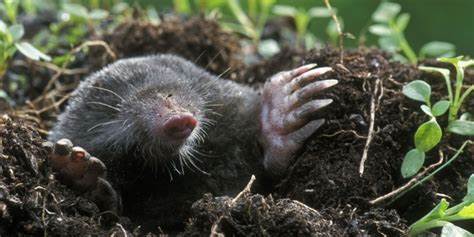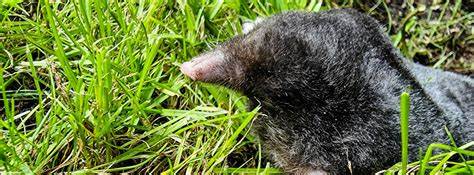In Berkeley, California, Casa Latina was the top-rated “mole” spot in July 2024, with a 4.2 score from 1.6k reviews. This fact shows how curious people are about moles with many asking “do moles really bite”. Moles are small animals that live underground, and they often surprise us with their behavior.
This article will clear up the myths about mole bites. We’ll look into mole behavior, when they might get aggressive, and how to act if you meet one. It’s for anyone interested in nature, gardening, or just wants to know more about moles. We aim to give you the real story and why moles are important in our world.

Understanding Mole Behavior
Mole Instincts and Defense Mechanisms
Moles are fascinating creatures with unique instincts and defense mechanisms. They live alone, digging tunnels underground. They look for food like earthworms and grubs.
They have strong front paws and a sharp snout, perfect for digging. A mole can dig up to 100 feet in a day. These tunnels are their homes and help them find food.
Most Moles don’t bother humans, but they can defend themselves if needed. They might squeal loudly, thrash, or bite when threatened. This keeps their territory safe and helps them survive.
There are different sizes of Moles, from the tiny American Shrew-mole to the big Townsend’s Mole. Their size and behaviors help them live well underground.
In summary, Moles are amazing creatures made for life underground. They have skills and behaviors that let them dig and protect themselves. This makes them great at living in the hidden world under our feet.
Mole Interactions and Encounters
Moles usually stay away from humans. But sometimes, they might be seen, leading to encounters. These can happen when moles make holes in lawns or gardens, or when they come out of their tunnels.
People often see moles through the hills of soil they dig. These hills can mess up lawns and gardens. Knowing how moles act and live underground can help people deal with these problems.
Moles are not usually mean to humans. But if they feel threatened, they might bite. Their teeth could cause small cuts. But moles biting people is rare, and they don’t spread diseases easily.
- Three species of moles native to Virginia: Eastern mole, hairy-tailed mole, and star-nosed mole
- Eastern mole is the most widely distributed within Virginia, occurring statewide except at elevations exceeding 2,000 feet
- Star-nosed mole commonly found in the northern Piedmont, Coastal Plain, and Tidewater regions of Virginia
- Hairy-tailed mole found along and west of the Blue Ridge Mountains at higher elevations above 2,500 feet
Moles live alone and spend most of their time underground. They eat underground bugs, which helps control pests. But, their digging can harm gardens, lawns, and landscaping.
Knowing how to handle mole encounters is important. Homeowners and gardeners can use repellents, change the soil, or put up barriers. Taking these steps can help keep your outdoor areas nice and peaceful with moles around.
Mole Bites and Aggression
It’s rare for moles to bite people, but it can happen. This usually happens if someone touches a mole or if it feels threatened. Moles have strong claws and jaws for digging, but they don’t bite humans on purpose.
When moles dig, they can damage lawns and gardens. This might make it seem like they’re being aggressive. But, it’s just how they live and dig their tunnels.
If a mole does bite, the wound is usually small. Moles don’t have diseases like rabies that could harm humans. Still, it’s best to see a doctor if bitten, just to be safe.
To keep moles away and prevent bites, call a pest control service. They can use traps, change the habitat, or set up barriers. This way, you don’t have to deal with moles directly.
Mole Dangers and Precautions
Moles don’t directly threaten human health, but they can cause problems. Knowing the dangers and how to prevent them helps homeowners and gardeners deal with moles.
Moles can harm lawns, gardens, and landscaping. They eat a lot, often as much as their body weight in one day. This can damage plant roots, making plants wilt or die. The soil mounds they leave behind are also a problem, making it hard for people and machines to move around.
Another issue is the risk of spreading diseases through their tunnels. Moles carry parasites and illnesses that can affect humans or pets. If you touch a mole, you could get skin infections like cellulitis.
- Moles have a ravenous appetite, often consuming their body weight in food daily.
- Mole infestations can damage lawns, gardens, and landscaping through their extensive tunneling activities.
- Moles can carry parasites and diseases that can be transmitted to humans or pets.
- Scratching or picking at a mole can lead to skin infections like cellulitis.
To reduce mole risks, act early. Spotting molehills or damaged plants is important. Getting help from experts like Big Blue Bug Solutions can solve mole problems and stop more damage.
Keeping your lawn healthy and aerated can also deter moles. Check your property for moles often and act quickly if you find them. This keeps your outdoor areas safe and healthy.
Understanding mole dangers and taking steps to prevent them lets homeowners and gardeners enjoy their yards safely. This way, you can avoid damage and health issues from moles.
Conclusion
In conclusion, we’ve learned that moles are not as aggressive as we thought. They have sharp teeth but usually don’t bite humans. By understanding how moles behave, we can live with them better without fear.
This article has given us a clear view of mole behavior, mole bites, and mole aggression. It shows how to live with moles. Now, we can meet moles with knowledge and respect, solving problems without hurting them.
To live well with moles, we need to know their nature and use kind methods to control them. With this knowledge, we can keep moles out of our yards without fear or cruelty. This way, we help the environment and live in harmony with moles.
